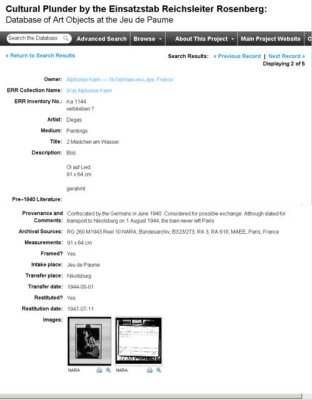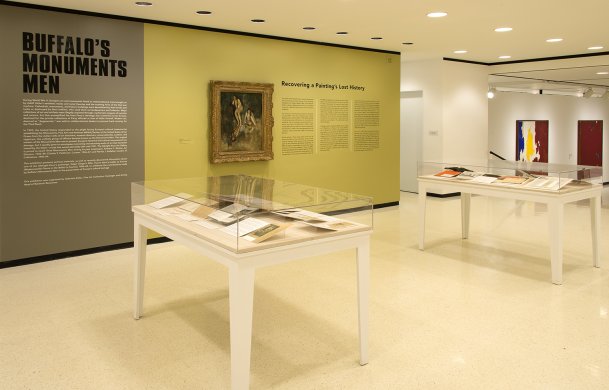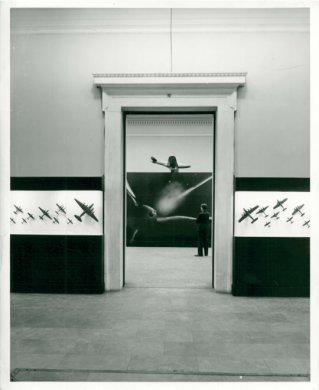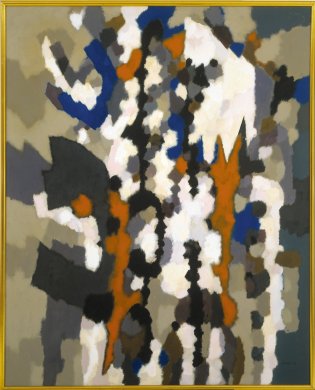The release of the film Monuments Men, based on the book of the same title, is especially timely given the recent revelation that in 2012, German officials discovered more than 1,400 artworks in the dingy Munich apartment of Cornelius Gurlitt, son of collaborationist art dealer Hildebrand Gurlitt. Monuments Men traces the activities of members of the Monuments, Fine Arts, and Archives Section of the Allied Forces as they located, protected, and returned artworks confiscated by the Nazis during World War II.
The Albright-Knox recently had a discovery of its own regarding the fate of one our paintings during the war—albeit one with a much happier ending, in which the artwork was long ago restored to its rightful owner. While working on a project to make more information about the Albright-Knox’s artworks accessible through MIMSY, our collection database, the art collection cataloger needed to gather some biographical information about Alphonse Kann, a former owner of Edgar Degas’s Mlle Fiocre dans le ballet La Source, 1866–68, in order to improve his record in the database.
She learned that though Kann, a French Jewish art dealer, was listed in the museum’s documentation as owning the painting until his death in 1948, he had in fact fled Paris in 1938 or 1940, leaving behind his art collection, which was seized by the Germans in 1940.
If Kann was separated from his collection, what was the fate of Mlle Fiocre during the war? Had Kann managed to take it with him to London? Or was it among works looted by the Nazis?
Further research revealed the existence of the ERR Project and its Jeu de Paume Database. Headed by Alexander Rosenberg, the Einsatzstab Reichsleiter Rosenberg (ERR) (“Taskforce of Reichsleader Rosenberg”) was one of the main agencies engaged in the plunder of cultural objects in Nazi-occupied areas. Works seized by ERR agents in France and Belgium were housed in Paris’s Jeu de Paume, where the Sonderstab Bildende Kunst (“Special Staff for Pictorial Art”) inventoried each work before it was transported to other parts of the Reich for the private collections of Nazi dignitaries, or to be sold for hard currency.
The Jeu de Paume Database unites the ERR inventory cards with additional research about a work’s disposition during and after the war to create a resource that users can search to find out if a work was seized by the ERR, and whether it was ever returned to its rightful owner. In fact, German officials used the database to verify that eight of the works among the 1,400 found in Cornelius Gurlitt’s apartment were indeed illegally obtained during World War II.
A search in the database revealed that Mlle Fiocre, listed as 2 Mädchen am Wasser (Two Young Women by the Water) but instantly recognizable by its photograph, was indeed seized by the Germans in June 1940 and taken to the Jeu de Paume. In a lucky turn of events, though “slated for transport to Nikolsburg on 1 August 1944,” the painting was on a train that never left Paris.
If you have already read Monuments Men, you might be asking yourself, “Is that the same train … ?!” Though we can’t be absolutely certain, it seems very likely that, yes, the Albright-Knox’s painting was on the train that is the subject of the dramatic events recounted in a chapter titled simply “The Train.” During the summer of 1944, liberation forces moved closer and closer to Paris, and “[b]y August 1, the endgame had begun. The Germans were clearing the museum, rushing to get everything out before the Allies arrived … [H]apless German soldiers … were banging paintings together and shoving [artworks] into crates without packing material” (Monuments Men, 180–81). One hundred forty-eight crates of artworks were rushed from the Jeu de Paume to the Aubervilliers train station in the city’s northern suburbs and loaded onto five railcars, where they sat … and sat … and sat.
A series of delays—including some orchestrated by the French Resistance, which had been tipped off to the train’s contents—kept it in the station for three weeks. When it finally departed, the overloaded train made it only a few miles before breaking down. After the Resistance engineered a bottleneck by derailing two engines farther up the line, the art train’s fate was sealed. The German occupying force in Paris surrendered on August 25, 1944, and the train remained in what was now liberated France.
On July 11, 1947, Mlle Fiocre was returned to Alphonse Kann. Sadly, he never recovered all of his collection, as a lack of records and his aging memory meant he could not provide a complete inventory of the works he’d left behind. Kann died a year later, and Mlle Fiocre was inherited by unnamed heirs, who subsequently sold the painting. By 1952, it was owned by a dealer named Walter Feilchenfeldt, Sr., who sold it to Paul Rosenberg & Co. in New York. On March 10, 1958, Rosenberg & Co. donated the painting to the Albright Art Gallery, as the museum was then known, where it has remained for the past half-century, its fraught past lost to history until the need to create a database record for “Alphonse Kann” led us to the ERR Project’s database, and, ultimately, a fuller appreciation of this painting’s fascinating provenance.







